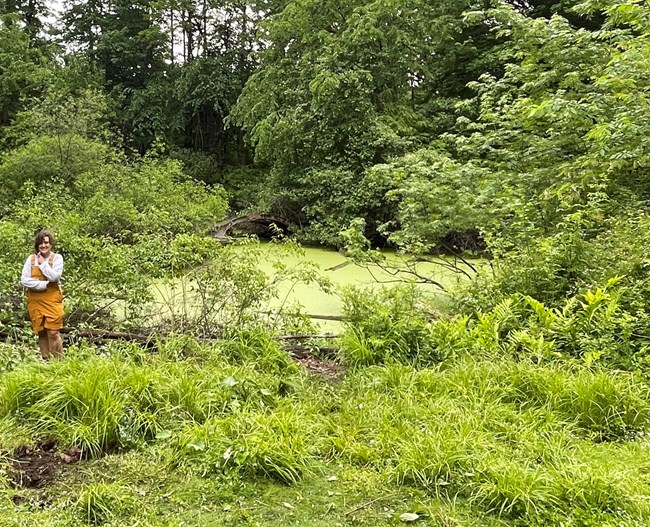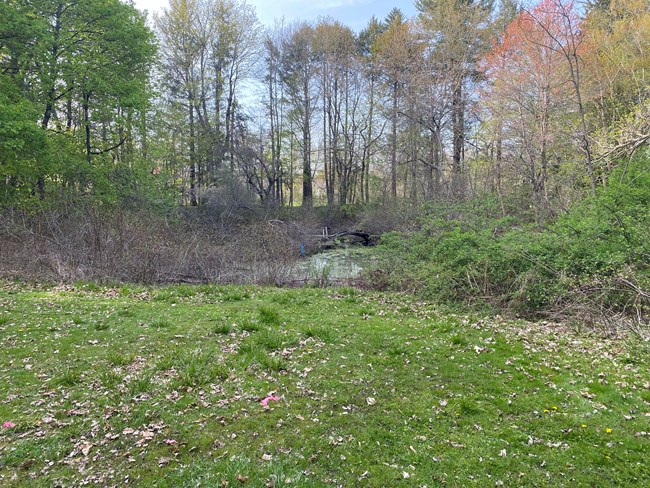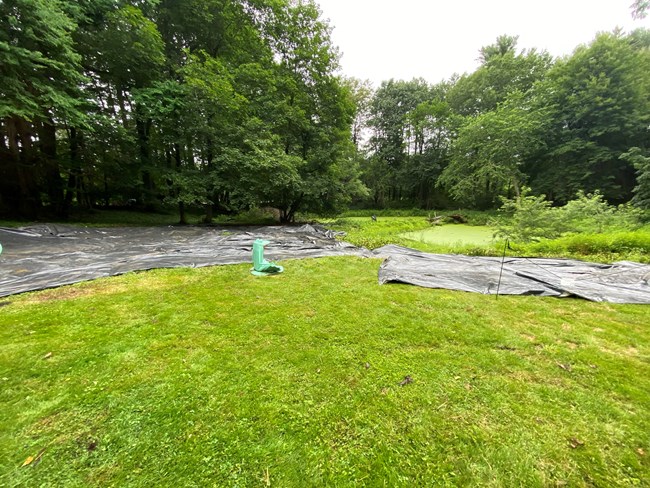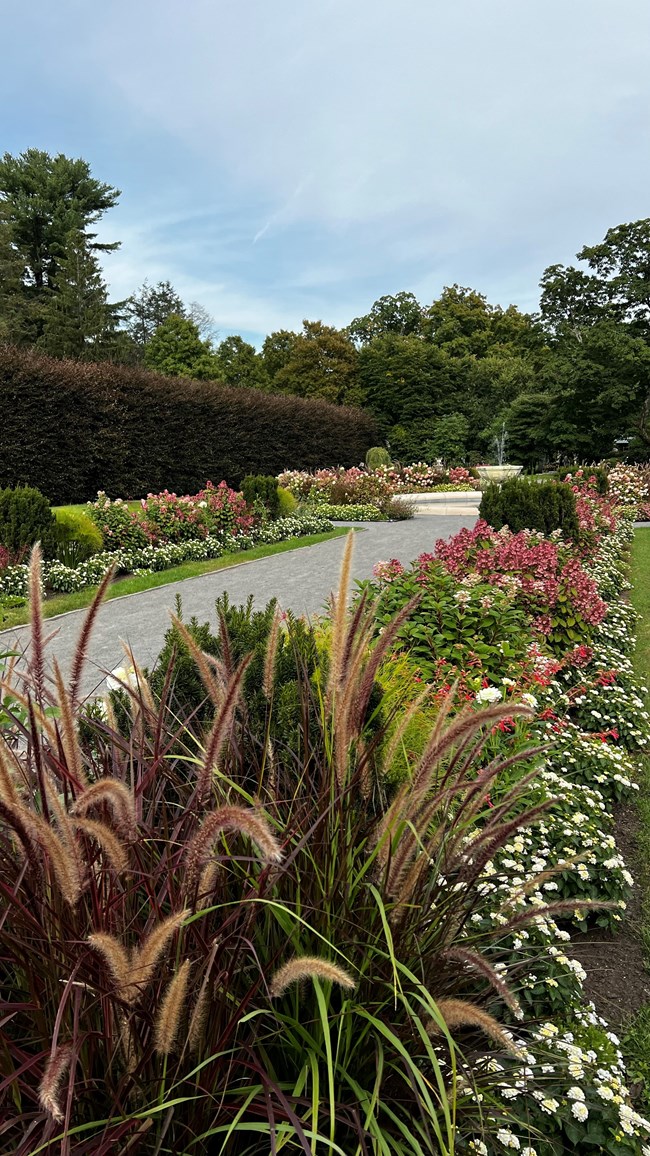Last updated: September 12, 2023
Article
Podcast 135: Pursuing a Career in Preservation Horticulture
Combining Horticulture and Conservation

Image courtesy of Karen Daubmann.
Erin Fogarty: Erin Fogarty, the Conservation and Historic Gardens Horticulturist at the Gardens at Elm Bank in Wellesley, Massachusetts.
Catherine Cooper: Thank you so much for joining us today. Could you talk about how you decided to combine horticulture and conservation?
Erin Fogarty: So, I want to preface it by saying that I grew up in an area with a lot of public gardens. My childhood home was more or less 15 minutes from Winterthur, Longwood, Hagley, the cream of the crop of historic gardens. So I had a lot of exposure to historic public gardens and horticulture from a really, really young age. I've always liked being outside. I've always liked history, especially in regard to architecture. And when I was looking at grads, I was given the opportunity by Dr. Jules Brook, a professor who later became my advisor that I really loved working with, who said, "Hey, I have this historic garden called Gibraltar in Wilmington, Delaware that we'd like to do some historic preservation planning on.
Little did she know that this is a garden I went to when I was nine years old. And ever since then I've wanted to make it beautiful again. I think that landscapes are really, really fascinating. They're constantly changing. So unlike a period room or a historic building, to a lesser extent, you could spend all the time in the world maintaining a historic landscape or you could leave it completely alone, put a fence around it, never touch it, and you're still impacting what it looks like 10, 15, 20 years in the future, which is terrifying, but it's also such a cool opportunity.
Implementing Preservation Horticulture

Image courtesy of Erin Fogarty.
Erin Fogarty: Really it depends on who you ask. It's in some ways a really old field. We have conservation of historic landscapes going back to the Ladies Mount Vernon Association in the 1860s, but as a data backed and records backed kind of systemic discipline, it's really new. For me it kind of has a similar vibe to translating literature. So you take every single thing you know about a garden or a piece of art or whatever, but also social context in which it was created. A lot of the landscapes that I've worked on were developed in a time before the estate and capital gains tax, which does really, really impact what people were doing and how they were doing it. And use all of that in combination with knowledge of what it's like right now. So how many people are there to take care of it? Is it open to the public? What's its environmental vibe? And use all of that to restore it in a way that honors that original vision, while also making sense for both its current environmental situation and also to the people who will be using it and interacting with it.
So, something that I always end up having to do is adjusting plantings for changing shade conditions. So they plant trees, they want them to be little, the trees were left alone, now they're 60 feet tall. That changes what you can do there. That has happened to me before. Transitioning from it just being a garden in someone's backyard to a garden that is now visited by the public, tens of thousands of people per year; knowing if the owner had access to a greenhouse that would impact what plants they could put in, things like that. Basically finding out what made it special when it was created, and finding a way to convey that specialness. And on the day today, it's a lot of just being covered in dirt.
Working for Massachusetts Horticulture Society
Catherine Cooper: Congratulations on your new position with the Massachusetts Horticultural Society. Could you tell us about your current project for them?
Erin Fogarty: Yeah, so Massachusetts Horticultural Society is a public garden in an old Estate in Wellesley. So about half an hour outside of Boston, give or take. And the garden was designed in 1916 by Percy Gallagher. He worked for Olmsted Brothers Firm and it was designed for Alice Cheney Baltzell, whose father had a major role in the founding of both American Express and Wells Fargo. So what we’re talking about is like unlimited money. [Olmsted Brothers] designed a bunch of gardens, but one of the gardens they designed was a kind of Asian inspired water garden. So it’s an Asian Japanese garden made by a white guy who’d never really been to Japan, if that makes sense. But it’s a time period where everyone was really, really interested in that style of design. Elm Bank was not really gardened for about 70 years from 1938 to 1996, in which time that this Asian garden was not managed and all these plants which were brought over and kind of introduced to American gardens from Japan, many of them did so well in the area that they’re now invasive plants.
So right now, my job is to rehabilitate this water garden in a way that, again, honors the original design while making sense for us right now. It’s a super cool design. It’s basically a kidney shaped pond with a bridge in the center modeled after the Shinkyo Bridge in Nikko, Japan. If you’ve seen that Japanese red bridge, that’s what it looks like surrounded by really dense, overflowing beds of mostly woody perennials that continue in a curated woodland for about a little bit over an acre. And I’m holding off because the main things that define the project are its challenges, which I know you’re going to ask about in a second.
Erin Fogarty: Yeah, so Massachusetts Horticultural Society is a public garden in an old Estate in Wellesley. So about half an hour outside of Boston, give or take. And the garden was designed in 1916 by Percy Gallagher. He worked for Olmsted Brothers Firm and it was designed for Alice Cheney Baltzell, whose father had a major role in the founding of both American Express and Wells Fargo. So what we’re talking about is like unlimited money. [Olmsted Brothers] designed a bunch of gardens, but one of the gardens they designed was a kind of Asian inspired water garden. So it’s an Asian Japanese garden made by a white guy who’d never really been to Japan, if that makes sense. But it’s a time period where everyone was really, really interested in that style of design. Elm Bank was not really gardened for about 70 years from 1938 to 1996, in which time that this Asian garden was not managed and all these plants which were brought over and kind of introduced to American gardens from Japan, many of them did so well in the area that they’re now invasive plants.
So right now, my job is to rehabilitate this water garden in a way that, again, honors the original design while making sense for us right now. It’s a super cool design. It’s basically a kidney shaped pond with a bridge in the center modeled after the Shinkyo Bridge in Nikko, Japan. If you’ve seen that Japanese red bridge, that’s what it looks like surrounded by really dense, overflowing beds of mostly woody perennials that continue in a curated woodland for about a little bit over an acre. And I’m holding off because the main things that define the project are its challenges, which I know you’re going to ask about in a second.
Challenges of Preservation Horticulture

Image courtesy of Erin Fogarty.
Erin Fogarty: Okay. So there are three major challenges. The least challenging thing is that we don’t really have any pictures of the site. The woman who commissioned it, Alice, was really, really private, like so private that the only photos we have of the garden were those that were taken by force when the garden won a Massachusetts Horticultural Society award. So, an award for garden design in the 1930s. As part of winning the award, the garden had to be written about [and photographed] in a landscape magazine. So we have those, but those are mostly detail shots. So there’s nothing really showing the whole garden. And I have plant lists, I have blueline drawings, but it’s really difficult from the shots we have to tell what in that design was and was not implemented. But that’s not a huge deal. I have the designs, I know what they meant to put there.
The second most challenging thing is our site. So,the garden is located within a protected wetland area associated with the Charles River. And because of that, any decision we make will have the potential to impact someone’s garden 10-15 miles downriver. We are working with a local Conservation Commission, and, we file permits and they give us permits to tell us what we can and can’t do with the site. So right now what I am allowed to do is I can use any mechanical means, any physical means of removal I want. I can’t use any chemicals, I can’t use any stump treatments, which again considers that we’re so close to the water. And the river does have a really, really big impact on the people of who live here in eastern Massachusetts; it’s great, but being that close to the river does lend its challenges.
And we also have a really, really significant population of invasive species. So the site after Alice Cheney died in 1938, there was a minors seminary, so like a seminary but for children who used the site until 1971 and they practiced what’s known as mow and blow maintenance. So they would mow the grass, they would blow out the leaves, leave everything else alone. Then it was a tech school for a couple of decades until Massachusetts Horticultural Society took it over in 1996. And again, when the tech school was there, they didn't really do much in terms of maintenance of this area, especially because it's kind of out of the way of the main drag of the estate. So we have a ton of invasive species that were allowed to grow functionally unchecked for 60 or 70 years. What that means is that there's a lot of cutting, there's a lot of sawing.
There is a lot to do to just peel back the layers and find out what the physical boundaries and any physical features of the site would be. So there's stuff growing over that flagstone path that I mentioned earlier, which allegedly the flagstones were taken from the restoration of Independence Hall in Philadelphia in the early 19 teens. I'm not sure if I believe that or not, but there's some big species everywhere. Our main issues are. Glossy buckthorn (Rhamnus frangula) and Multiflora rose (Rosa multiflora) round-leafed bittersweet (Celastrus orbiculatus), things like that. All but the bittersweet were introduced to the site intentionally as part of the original design. Which is cool. I mean, it's an interesting story to tell about how horticulture has changed, but trying to dig out the site from the growth has been a lot.
Making and Executing a Plan
Catherine Cooper: What are your goals for the completion of the project?
Erin Fogarty: We are aiming for a really slow, really conscious rehabilitation. The traditional way things like this have been practiced are you pay an architectural firm six figures, they come in, they do a big plan for the site, and then you drop another six or seven figures in an all-in-one restoration where you take everything out and then you put new stuff back in. But the view we're taking is kind of gardening the garden back to life. So what that means is that we are just gardening it and making slow but meaningful steps towards turning it back into something, which allows us to use the area for education. So for training people in landscape remediation, landscape history, environmental stewardships, and it also allows us to find cool stuff that would've been lost if we were to rip everything out all in one go.
I found some mountain laurel and some snowball bushes that were covered by bittersweet for God how many years, and that granularity is really, really cool to be able to do. And also being able to get people out there, get them into the woods. It's a really once in a lifetime project, it's really cool. I want to retain the original feel of the design while adjusting for where it is now. Right now I am data gathering for the 198 species in the original design. So that means finding original descriptions in catalogs from the 1920s. That means figuring out where all the species are from, what kind of light conditions they like, both to figure out what that original design felt like and to propose potential replacements.
Catherine Cooper: Are you allowed to use invasive plants in remediation of a design?
Erin Fogarty: I don't think that the Conservation Commission would allow us to do that. Also, just because of the wet nature of the soil, it would be a bad scene. That's not to say we're dead set on using only native species. Because of the nature of the site, there are some native species that are really, really aggressive. I know I talk about dealing with bittersweet and buckthorn all the time, but one of our biggest tests have been native grapevines. Just trying to pull these huge, huge vines out of the canopies of trees. They're native, but that doesn't mean they're right for what is there. We'll probably end up using non-native species, but we most likely will not use any invasive species. That's not to say we'll be getting rid of some of our larger specimens of things like Norway maple (Acer platanoides). Those might stay, but I don't anticipate introducing any more invasives to the site.
Catherine Cooper: So how do you make recommendations for replacements in a plan like this?
Erin Fogarty: It all just depends on what each individual plant contributed to the landscape. What function it was playing, both ecologically and aesthetically. So I'll usually look at when it flowered or when it looked its best, which usually means flowering, but could be in foliage color and what textures and what colors it would be bringing to the landscape at that point in time. And finding something that would mimic that as well as it could for the site while not also causing an issue. How do you replace something like English ivy, which has something that non-invasives don't always have. Texture that was used as a ground cover that has the waxy leaves that's really, really low. How do you find something that has all of those things that won't stick out in the design but will also not be super aggressive and not climb up the trees?
Erin Fogarty: We are aiming for a really slow, really conscious rehabilitation. The traditional way things like this have been practiced are you pay an architectural firm six figures, they come in, they do a big plan for the site, and then you drop another six or seven figures in an all-in-one restoration where you take everything out and then you put new stuff back in. But the view we're taking is kind of gardening the garden back to life. So what that means is that we are just gardening it and making slow but meaningful steps towards turning it back into something, which allows us to use the area for education. So for training people in landscape remediation, landscape history, environmental stewardships, and it also allows us to find cool stuff that would've been lost if we were to rip everything out all in one go.
I found some mountain laurel and some snowball bushes that were covered by bittersweet for God how many years, and that granularity is really, really cool to be able to do. And also being able to get people out there, get them into the woods. It's a really once in a lifetime project, it's really cool. I want to retain the original feel of the design while adjusting for where it is now. Right now I am data gathering for the 198 species in the original design. So that means finding original descriptions in catalogs from the 1920s. That means figuring out where all the species are from, what kind of light conditions they like, both to figure out what that original design felt like and to propose potential replacements.
Catherine Cooper: Are you allowed to use invasive plants in remediation of a design?
Erin Fogarty: I don't think that the Conservation Commission would allow us to do that. Also, just because of the wet nature of the soil, it would be a bad scene. That's not to say we're dead set on using only native species. Because of the nature of the site, there are some native species that are really, really aggressive. I know I talk about dealing with bittersweet and buckthorn all the time, but one of our biggest tests have been native grapevines. Just trying to pull these huge, huge vines out of the canopies of trees. They're native, but that doesn't mean they're right for what is there. We'll probably end up using non-native species, but we most likely will not use any invasive species. That's not to say we'll be getting rid of some of our larger specimens of things like Norway maple (Acer platanoides). Those might stay, but I don't anticipate introducing any more invasives to the site.
Catherine Cooper: So how do you make recommendations for replacements in a plan like this?
Erin Fogarty: It all just depends on what each individual plant contributed to the landscape. What function it was playing, both ecologically and aesthetically. So I'll usually look at when it flowered or when it looked its best, which usually means flowering, but could be in foliage color and what textures and what colors it would be bringing to the landscape at that point in time. And finding something that would mimic that as well as it could for the site while not also causing an issue. How do you replace something like English ivy, which has something that non-invasives don't always have. Texture that was used as a ground cover that has the waxy leaves that's really, really low. How do you find something that has all of those things that won't stick out in the design but will also not be super aggressive and not climb up the trees?
Getting into Preservation Horticulture

Image courtesy of Massachusetts Horticultural Society.
Erin Fogarty: Truly the number one recommendation is to get out there and find a garden, and garden. You can find local historic landscapes through the Garden Conservancy. They're a really popular group that assists in preserving and transitioning private landscapes to public landscapes. You can also go on a website called Garden Visit to look for landscapes in your area. So find a landscape, find one that speaks to you, and start finding out how you can volunteer. That's the best way to learn and to understand landscapes is to actually spend a lot of time there working the land, engaging with it, learning its little quirks. There's a reason that if you're at a landscape for less than a year, you don't really know it. Your first year working at any landscape is just figuring it out. It doesn’t require a lot of skill and the gardeners would totally be thrilled to have you help out. I know I would. If you're in the Boston area, come hang out with us at Elm Bank.
You could also start studying the history of your area. One of the things that's really popular and that I like to do is in spring, go into the woods and go daffodil hunting. If you find daffodils in the middle of the woods, you're likely to find an old house foundation or an old sidewalk or a street. They're a pretty good indicator. So just learning the history of your area. But in terms of stuff you can do from home, looking at pictures and documents in the Smithsonian Archive of American Gardens, a lot of which is digitized for gardens that you might be interested in gardens in your area.
There are some good books by a person named Robyn Karson that you can check out at your local library that are a cool read if you're interested in historic landscapes from a historical design standpoint. If you're looking at colleges, looking at grad school levels, look at historic preservation programs. I'll always... University of Delaware's historic preservation certificate program. You're in an area with a lot of historic gardens, take a visit to Philadelphia so you can check out some historic landscapes, things like that. Number one recommendation is to just garden. That's the best way you can learn about plants, how they were used, is just to spend time outside.
Visit Elm Bank. Visit Gibraltar in Wilmington, Delaware if you have the chance. Gardens are cool. I mean spend time outside. A lot of people tend to overlook historic gardens as something for older people or something pretty traditionalist. But there's some really, really, really cool stuff happening in terms of historic landscape preservation across America right now. Check out places like Bartram's Garden, if you can. You're in the area. It's awesome.
Catherine Cooper: So if someone wanted to visit Elm Bank, are there particular hours or email in advance?
Erin Fogarty: We're open 10:00 AM to 4:00 PM or 10:00 AM to 6:00 PM depending on the day from April 1st through the end of October. We're also open at the Christmastime for a lights thing. But if you were to go on the website and sign up for the volunteer list, you would get emails when we are working in the water garden, and that is something that happens year round. You can find me on Instagram at @Old.Plants, I'm trying to put more of the gardening stuff on there. Also follow Massachusetts Horticultural Society at @Masshort, and that way you can keep on top of all the relay really cool stuff we're working on.
Catherine Cooper: Wonderful. Thank you so much for speaking with us and taking the time.
Read other Preservation Technology Podcast articles or learn more about the National Center for Preservation Technology and Training.
